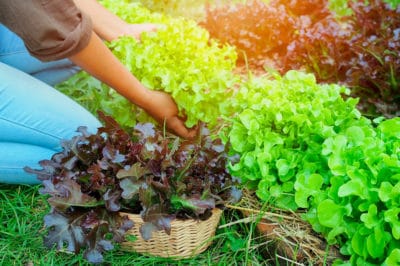When to Harvest
Timing is everything when it comes to harvesting lettuce. Leaves harvested during hot or dry periods will often wilt within hours. Farmers harvest leaf lettuce in the early hours between 2 a.m. and sunrise. Harvest leaves anytime if they are going straight into a dish. Otherwise, for lasting storage get to the leaves before the morning dew evaporates.
How to Harvest
What you’ll need:
- Scissors
- Bucket
- Ice
- Water
Do this at any time during the plant’s lifecycle. Leaf lettuce can be eaten as a microgreen, a baby leaf, or a mature salad green. Take your scissors and cut the leaves about 1 1/2 inches from the soil surface. Make sure to leave the root systems intact, and not to damage the lower stem that supports the root structure.
Take the leaves and plunge them into a bucket filled with ice water. This will crisp them up and allow them to soak in as much water as possible so that they’ll store for longer. Leave them in the bucket for 20 minutes, then take them out and dry them off. Excess moisture during storage can cause rot. Store them in a plastic bag in the refrigerator for up to three weeks.
Leaf lettuces will regrow after being cut as long as the root systems were not damaged. It should produce another harvest within two or three weeks. You can continue this process through the season or until the heat sends the plants into the flowering phase.
Seed Harvest
Once your lettuce plants have flowered, there’s no rush to pull them out. If you don’t require the garden space, consider leaving them to seed and collecting it for next year’s garden. After the flowers bloom and wilt, feathery parachute structures will form. These parachutes are designed to carry the lettuce seed on the wind and deposit it in new areas.
Each parachute called a ‘pappus’ is attached to two or three tiny elongated seeds. Collecting these seeds by hand is simple, just rub them between two fingers until they release from the pappus. Store the seed in a cool, dry location and plant it next spring for a new crop.
